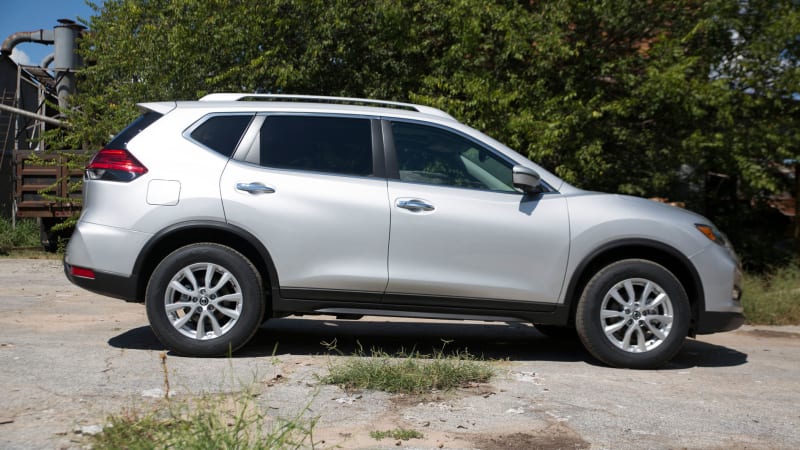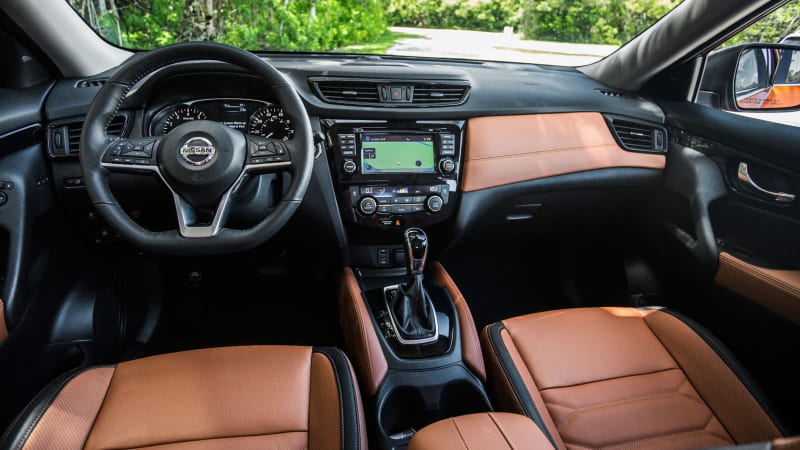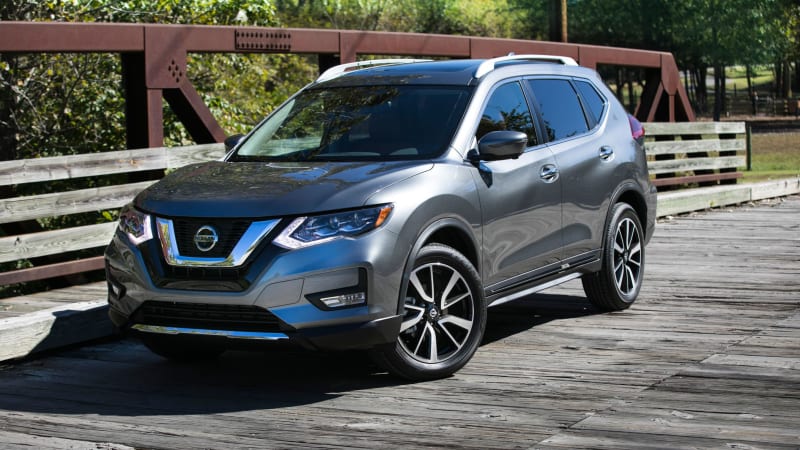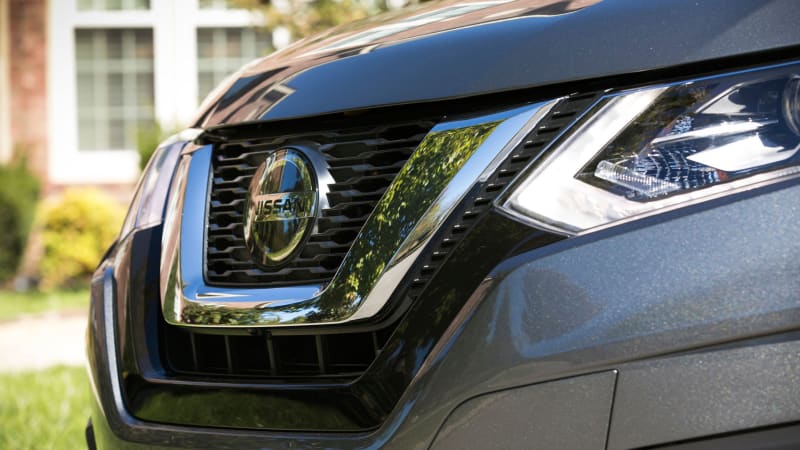Dynamically speaking, the Rogue is only mid-pack (at best) among rivals that include the Toyota RAV4, Honda CR-V, Mazda CX-5, Ford Escape, Chevrolet Equinox and Hyundai Tucson, to name a few. That’s because the Rogue’s 2.5-liter four-cylinder engine is hardly what you’d call a tire-burner, and it’s paired with an economical but uninspiring CVT automatic transmission. Available in front- or all-wheel drive, the Rogue puts much more emphasis on fuel economy, cargo room and cabin quality. For many compact-SUV buyers, those attributes rank highly.
Here you’ll find all the information needed to make an educated buying decision if you’re considering a 2018 Nissan Rogue, including safety and reliability ratings, engine specs, horsepower, fuel economy ratings and pricing.
We should note that this guide does not cover the Rogue Sport crossover, which is different enough from the regular Rogue to warrant its own guide.
We’ll also summarize what Autoblog’s professional auto reviewers think of the Rogue.
Is the 2018 Nissan Rogue Safe?
The National Highway Traffic Safety Administration gives the 2018 Nissan an overall crash-test rating of four stars. Whether equipped with front- or all-wheel drive, the Rogue scored identical four-star scores in the frontal and crash test, along with resistance to rollover. A five-star score was recorded for the side-impact crash test.
The Insurance Institute for Highway Safety, which provides ratings for new vehicles based on its own comprehensive crash tests, has given the 2018 Nissan Rogue its “Top Safety Pick” award.
The Rogue earned a “superior” rating for front crash prevention, along with “good” ratings in all of the IIHS’ crash tests. The Rogue scored only an “marginal” rating for its LATCH anchors for child seats. Headlamp performance received an “acceptable” rating.
Ratings may differ for Rogues from other model years, so be sure to visit the NHTSA and IIHS websites to review ratings on the specific vehicle you’re researching.
At the time of this writing, the 2018 Rogue is not listed as being part of any ongoing recalls.

Is the Rogue reliable?
J.D. Power most recently reviewed initial quality in the 2017 Rogue, which is nearly identical to the 2018 model, excluding minor trim changes. It gave the Rogue four out of five possible stars — a rating referred to as “among the best” — for overall quality, as well as overall performance and design.
The Rogue’s scores noticeably fall in other categories, however. J.D. Power gave the Rogue only two stars for predicted reliability, along with a three-star rating for body and interior quality design, features and accessories quality design and overall quality design.
A note about J.D. Power’s methodology: We have some rather serious issues with the way it weights serious and less-serious reliability issues. Read more about that here.
How much interior and cargo room does the Rogue have?
The 2018 Nissan Rogue seats up to five people, with 43.0 inches of front legroom and 37.9 inches in the backseat. Passengers get 41.6 inches of front headroom and 38.5 inches in the rear seat (without the optional moonroof fitted).
The Rogue offers 39.3 cubic feet of cargo volume with the second-row seats in the upright position. With the rear seats folded, the Rogue provides a total of 70.0 cubic feet of cargo room.
For comparison, the 2018 Honda CR-V has 39.2 cubic feet of cargo room with its rear seats in place. Folded down, total volume is 75.8 cubic feet.

What are the Rogue engines and specs?
All versions of the Nissan Rogue (except the hybrid) come with the same engine, along with a choice of front- and all-wheel drive. Three trims are offered: S, SV and SL. Standard across the range is a 2.5-liter four-cylinder that delivers 170 horsepower and 175 pound-feet of torque. A continuously variable transmission (CVT) is the only gearbox available.
What fuel economy does the Rogue get?
The EPA rates the 2.5-liter four-cylinder and CVT in front-wheel-drive format at 26 miles per gallon in the city and 33 on the highway. Equipped with all-wheel drive, the same engine and transmission combination returns 24 mpg city/31 mpg highway.
Is there a hybrid Rogue?
There is a hybrid version of the Nissan Rogue. The hybrid model features a 2.0-liter four-cylinder engine coupled to an electric motor. Total output is 176 horsepower, which is almost identical to that of the standard model. Fuel economy is improved, to an EPA-estimated 33 mpg in city driving and 35 mpg on the highway.

Does the Rogue have AWD?
Yes, all trim levels of the Nissan Rogue can be optioned with all-wheel drive.
What is the MSRP of the Rogue?
The 2018 Rogue has a starting MSRP of $24,800 for the S trim equipped with front-wheel drive. Adding all-wheel drive pushes the base price of the S model to $26,150. A range-topping Rogue AWD SL model starts at $32,410.
Use Autoblog’s Smart Car Buying program powered by TrueCar to search out competitive local pricing and savings on the 2018 Nissan Rogue.
Can I read the latest review of the Rogue?
Autoblog last tested the Nissan Rogue for the 2018 model year, though primarily to see how the available Pro Pilot Assist system fared in real-world driving.
We were impressed by ProPilot, calling it a “great feature” that can help take some of the fatigue out of long drives. Coupled with the adaptive cruise control, the driving assist feature was a welcome companion during a drive to the Chicago Auto Show earlier this year.

“It became so effective on straight sections that I relaxed my hand to the point the steering wheel no longer detected my presence and the car warned me to put my hand back on the wheel,” wrote Autoblog Associate Editor Joel Stocksdale. “And, yes, like other adaptive cruise control systems with steering assist, ProPilot Assist does make you commit to this token gesture of control.”
While ProPilot has merit, the rest of the Nissan Rogue left something to be desired. As Stocksdale noted during this drive, the 2018 Rogue “is not the strongest crossover SUV.” While the ride was comfortable and the cabin spacious, the four-cylinder engine was “coarse” and the handling was “lackluster.”
To get a sense of how the Rogue’s closest competitors stack up, use our Compare Cars tool.
Related Video:
Source : AutoBlog















